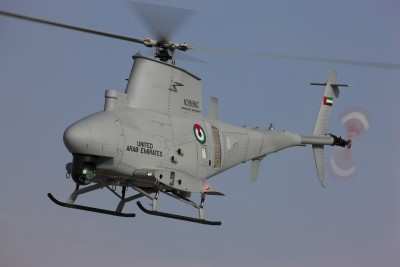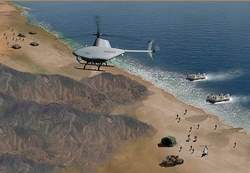Flights Conducted Under Extreme Environmental Conditions In
UAE
A rigorous set of flight demonstrations of the MQ-8B Fire Scout
vertical unmanned aerial system (VUAS) were completed by the
U.S. Navy, Northrop Grumman, and several subcontractors
Tuesday.

The test flights were conducted in early July over a ten day
period in the United Arab Emirates under what were described as
extreme environmental conditions. They validated Fire Scout's
steady system maturation and helped signal its readiness for the
U.S. Navy's upcoming Operational Evaluation of the system, planned
for late 2010 aboard the USS Halyburton (FFG-40).
"We welcome Northrop Grumman and the U.S. Navy to the UAE for
continued testing of the Fire Scout," said Ali Al Yafei of ADASI
(Abu Dhabi Autonomous Systems Investment). "As a VUAS, Fire Scout
has many unique capabilities to offer and we're looking forward to
reviewing the results of this in-country testing."
The Fire Scout demonstrations included numerous takeoffs and
landings in hot, windy and sandy conditions in temperatures as high
as 47 degrees Celsius (117 degrees Fahrenheit). The VUAS also
conducted various test flights at altitudes up to 9,842 feet. These
demonstration missions included non-line-of-sight operations that
showcased Fire Scout's ability to operate autonomously in remote
locations, and its FLIR Systems electro-optical/infrared (EO/IR)
sensing capabilities used to locate and acquire targets.

Video imagery from the testing was presented today at a
post-testing event to an audience of interested multi-national
government agencies, and domestic and international media. The
imagery, a compilation of video produced by Fire Scout's sensors
during field trials, demonstrated the VUAS's real-time
imagery-transmission capability, a vital element of the
intelligence, surveillance and reconnaissance missions it performs
for military forces.
"Today's demonstration was very impressive and reinforces the
continued maturation of the Fire Scout system and its
capabilities," said John Brooks, president of Northrop Grumman
International Inc. "Northrop Grumman thanks the UAE for being such
a gracious host and offering us the opportunity to test Fire Scout
in the extreme heat of summer. The UAE represents an important
partnership for Northrop Grumman and our customers internationally
demand the best. We are committed to continuing to meet and exceed
their expectations."

Artist's Rendering
The only U.S. Department of Defense VUAS program of record, Fire
Scout is a mature, flexible and reliable system whose capabilities
can serve as a true force multiplier.
"The capabilities that Fire Scout delivers to warfighters really
stood out today," said Duke Dufresne, sector vice president and
general manager for the Strike and Surveillance Systems Division of
Northrop Grumman's Aerospace Systems sector. "It's clear from this
demonstration that Fire Scout can do exactly what it's designed to
do: extend the range at which we can gather crucial information
during peacekeeping or wartime missions."
 ANN's Daily Aero-Linx (05.02.24)
ANN's Daily Aero-Linx (05.02.24) ANN's Daily Aero-Term (05.02.24): Touchdown Zone Lighting
ANN's Daily Aero-Term (05.02.24): Touchdown Zone Lighting Aero-News: Quote of the Day (05.02.24)
Aero-News: Quote of the Day (05.02.24) ANN FAQ: Contributing To Aero-TV
ANN FAQ: Contributing To Aero-TV NTSB Final Report: Cirrus Design Corp SR20
NTSB Final Report: Cirrus Design Corp SR20





